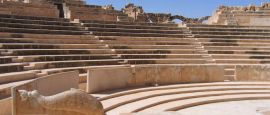The only standing reminder of Roman Oea is the Arch of Marcus Aurelius, erected in AD163. The triumphal arch was excavated to the original ground level, which suggests that most of Oea lies buried under the medina. The city's two main deities Apollo and Minerva are clearly visible on the gateway, and by the side are some carved blocks from a nearby Roman temple.
Things to see in Tripoli
Tourist offices
Address: Near the ferry port on the main coastal road, Tripoli, Libya
Tel: (021) 444 5336.
tourism.gov.ly/site/index.php/en/
Built in the 16th century on the site of a Roman castrum (fortified camp) by the Spaniards and the Knights of St John of Malta, the Red Castle was the official residence of the Turkish governors. Part of the complex is the Jamahiriya Museum and offices, but visitors can stroll through the intricate network of alleys and courtyards within the castle.
The most elegant in Tripoli, and the last Ottoman mosque to be built in Libya, is the Gurgi Mosque, built by Yusuf Gurgi in 1833. The interior has exquisite Turkish-style tile-work, Italian marble columns and Moroccan carved stucco.
This is Libya's largest museum, with a fine collection of artefacts chronologically arranged from the Neolithic period up to the present. Highlights include the fine reproductions of Saharan rock art from the Acacus Mountains, and superb Roman sculptures and mosaics from Leptis Magna. The colourful VW beetle in the entrance hall was Colonel Gaddafi's during the lead up to the1969 revolution.
The Old French Consulate near the Arch of Marcus Aurelius is in a restored 17th-century building with a central courtyard. Around the corner, on Sharia Hara Kebir, is the Old British Consulate behind the Gurgi Mosque, in a fine 18th-century house that was built for the ruling Karamanli family and used by the British consul until the 1940s. The roof terrace has great views across the medina to the modern harbour.
Tripoli's medina lacks the exoticism of Moroccan medinas and the bustle of Cairo's old city, but it makes for a pleasant and interesting afternoon stroll. The principal entrance is on Green Square, leading to the Ottoman clock tower, and various souks lead off it. The main drag is Sharia Jamaa ad-Draghut, with the Mosque of Draghut, which leads to the Roman Arch of Marcus Aurelius.
The Yusuf Karamanli house, a grand medina house built around a central courtyard with colourful Turkish tile-work, gives an insight into how wealthy people lived here 200 years ago. The rooms hold displays of traditional dress, period furniture, musical instruments and household objects.
Do you have any Feedback about this page?
© 2025 Columbus Travel Media Ltd. All rights reserved. No part of this site may be reproduced without our written permission, click here for information on Columbus Content Solutions.








 You know where
You know where